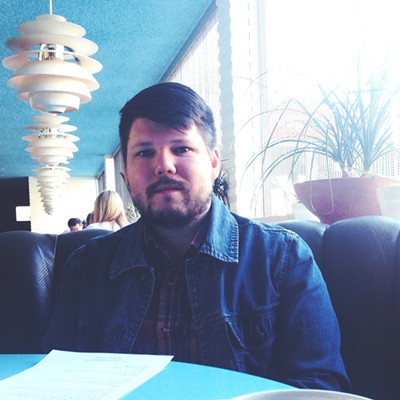"It feels good," Steinbrink says with a laugh. "But I'm always trying to avoid getting complacent. I'm always trying to one-up myself."
Steinbrink's new record, Next New Sun, does exactly that, melding the sparse folk-pop of earlier releases with spacey dynamics, MIDI string sections, and expansive percussion. All the strengths of a fantastic singer-songwriter record are present — the emotive, cryptic lyrics, the gorgeous melodies — without any of the self-indulgence that often strikes solo projects of the sort. Details like the disco-guitar break of "Bold With Fire Pt. 2," the grating train-track loop of the title track, and guest vocalist Katherine Steinbrink's contributions on "I Really Want (To Be Your Friend)" keep the record varied and surprising, something not often found in the music typical one-man acts. The record will be available on CD and LP later this year on Tempe-based Gilgongo Records, but Steinbrink is releasing on October 1 a special VHS edition of the album that pairs the songs with short films and music videos.
Steinbrink started playing music in the early 2000s, goofing around with a guitar the way most nascent musicians do. "I played guitar in junior high jazz band, and just screwed around, listened to a lot of Beatles records." It was getting a four-track tape machine for his 14th birthday that solidified his interest in music. "I spent a lot of time just learning about how to make things sound right," he says. He started playing guitar in Black Feet, an "old timey, really dark folk" combo. "We toured a little bit," Steinbrink says. "It's funny, because I went on that first tour, and I hated it. Absolutely hated it. I couldn't stand it. I never would have imagined that's what I'd end up doing so much of." After Black Feet disbanded in 2005, Steinbrink began writing songs under the name French Quarter, inspired after seeing the words on a friend's New Orleans souvenir shirt. "I just liked the way it looked spelled out."
Steinbrink started self-releasing CD-Rs when his friend John Ryan approached him about putting out a tape on Ryan's label Workout Tapes. Steinbrink began playing out a lot and started working under Bob Hoag's tutelage at Hoag's Flying Blanket Studios. "That ended kinda badly," Steinbrink says. "So after that, I was just confused and lost and disenchanted with things for a while. Then I just got the idea to quit my job, move out, and just tour constantly. Which is what I've done since then." Not long after his decision, James Fella, owner of Gilgongo Records, used his national distribution to put out the self-titled French Quarter debut record.
"James is one of my best friends," Steinbrink says. "So I was really excited to release the record with him. It was a strange kind of ordeal, though. I spent three months recording that album and then eight months mixing it." Steinbrink recorded the record using Garage Band, which presented a challenge because it was the first time he used digital instead of analog recording. The record hardly shows the signs of its being a novice effort, which is even more remarkable given the fact that Steinbrink recorded it with little more than an Apple laptop's onboard microphone. "Considering everything, I'm really proud of how it turned out."
While touring with Teague Cullen's Foot Ox, whose song "Beauty Will Prevail" is featured on Next New Sun, Steinbrink found himself in New Orleans and in hot water with a promoter.
"This guy was pissed at me about the band name. He said, 'You know, no one is coming to the show because of your band name.' Which is funny, because about 100 people showed up that night. No one was angry, like that guy. But everyone asked me about the name, considering that I'd never even been to New Orleans. It was just a stupid, unfounded band name. I just felt since the band is just me, it made sense to go under my own name."
Steinbrink recorded his next release for Gilgongo, Ugly Unknowns, without the French Quarter moniker. The record featured some of his most direct lyrics. Songs like "South of 13th" chronicled his thoughts about playing music professionally, while tracks like "I Don't Want to Get Stabbed" and "I Don't Ever Want to Die" grappled with mortality, poignant thoughts most likely inspired by late-night walks in downtown Phoenix. The record received mixed reviews. Though some (including this writer, who reviewed the record for Tiny Mix Tapes) found the album a brave assertion of personal identity, others took umbrage with the confessional tone, labeling it "childish."
Steinbrink shrugs it off: "I think a song's worth has to be based on how genuine or sincere you are. Which is why I don't feel too embarrassed about that last record. I feel that as 'whiny' as some of those songs were, I was being totally honest. Those were concerns I was worrying about and obsessing over. For a reviewer to make a judgment on what I do is kind of frustrating, but, I don't know who said it, 'You can't argue with a critic.'"
Perhaps the most consistently fascinating aspect of Steinbrink's work is the way his songs are constantly evolving. During Steinbrink's live performances, it sometimes takes a few minutes before a song becomes recognizable. When backed by a full band, his songs can take on an epic, Neil Young-like quality. Other performances may find him fashioning the songs into Arthur Russell-style minimalist disco. "I usually write songs at my eight-track," Steinbrink says. "The first, recorded version of [songs are] usually made as I write [them]. And those end up on the records." From there, the songs are subject to constant re-imagining and re-contextualization. "Lately, I've felt very uncomfortable playing any of my "negative" songs, and I'm really interested in moving them to a more positive place."
When asked if he feels that creating art in Phoenix has had any impact on his songwriting, he smiles. "I think that there's this really interesting thing going on in Phoenix. There's no central 'scene,' so you end up with all these different people playing every style of music imaginable." Steinbrink's music often reflects such a hodgepodge while maintaining a singularity and quality undisturbed by prevailing trends.
"I love that people in Phoenix seem to really seek out the great things going on here. They seem to want to squeeze every last possible drop of goodness from the city."










